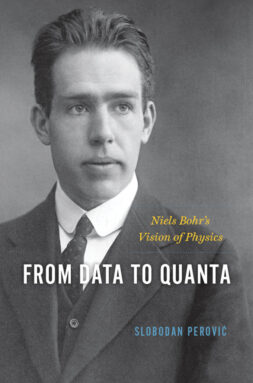
From Data to Quanta
Slobodan Perović
Univ. of Chicago, $45
Ever since Max Planck introduced the idea of the quantum to the world, physicists have argued about whether reality is more like sand or water.
Planck’s famous 1900 discovery that energy is grainy — at least when absorbed or emitted — moved him to label those smallest bits of energy grains “quanta.” But he believed that once emitted, as in light from a fire, those grains merged into smooth, continuous waves, just as water seems a smooth liquid to human perception. Einstein, on the other hand, insisted that light quanta traveled through space on their own, behaving like particles later called photons.
By the mid-1920s, both the wave and particle views of light had gained experimental support, with the additional paradox that electrons — supposedly particles — could sometimes disguise themselves as waves.
Into this arena of controversy stepped the famed Danish physicist Niels Bohr, the pioneer of exploring the architecture of the atom. Bohr announced that resolving the wave-particle paradox required a new view of reality, in which both notions shared a role in explaining experimental phenomena. In experiments designed to observe waves, waves you would find, whether electrons or light. In experiments designed to detect particles, you’d see particles. But in no experiment could you demonstrate both at once. Bohr called this viewpoint the principle of complementarity, and it successfully guided the pursuit of quantum mechanics during the following decades.
More recently, as philosopher Slobodan Perović recounts in From Data to Quanta, Bohr’s success has been questioned by some physicists and philosophers and even popular science writers (SN: 1/19/19, p. 26). Complementarity has been derided as an incoherent application of vague philosophy expressed in incomprehensible language. But as Perović’s investigations reveal, such criticisms are rarely rooted in any deep understanding of Bohr’s methods. Rather than Bohr’s philosophy contaminating his science, Perović argues, it is his opponents’ philosophical prejudices that have led to misstatements, misunderstandings and misrepresentations of Bohr’s physics. And Bohr can’t be understood by attempting to understand his philosophy, Perović asserts, because philosophy did not guide him — experiments did.
In fact, Bohr’s drive to understand the wave-particle paradox was fueled by a deep devotion to comprehending the experimental evidence in its totality. It was the same approach the younger Bohr took when developing his model of the atom in 1913 (SN: 7/13/13, p. 20). Various experiments suggested properties of the atom that seemed irreconcilable. But Bohr forged those experimental clues into a “master hypothesis” that produced a thoroughly novel understanding of the atom and its structure.

Sign Up For the Latest from Science News
Headlines and summaries of the latest Science News articles, delivered to your inbox
Client key* E-mail Address* Go
Thank you for signing up!
There was a problem signing you up.
Perović describes how Bohr’s process began with lower-level hypotheses stemming from features directly given by experiment. Spectral lines — different specific colors of light emitted by atoms — led to basic hypotheses that some vibratory process, of an atom itself or its constituents, produced electromagnetic radiation exhibiting precise patterns. Intermediate hypotheses about the structure of the atom did not explain such lines, though. And then Ernest Rutherford, on the basis of experiments in his lab, inferred that an atom was mostly empty space. It contained a dense, tiny central nucleus encompassing most of the mass, while lightweight electrons orbited at a distance. But that hypothesis didn’t mesh with the precise patterns of spectral lines. And such an atom would be unstable, persisting for less than a millisecond. From all these disparate experiment-based hypotheses, Bohr applied Planck’s quantum idea to construct a master hypothesis. He reconciled the spectral lines and Rutherford’s nuclear atom with a new atomic model, in which electrons maintained stability of the atom but jumped from one orbit to another, emitting specific patterns of spectral lines in the process.
As Perović demonstrates, Bohr followed a similar course in arriving at complementarity. While numerous experiments showed that light was a wave, by the early 1920s other experiments established that X-rays, highly energetic light, collided with electrons just as though both were particles (momentum and energy were conserved in the collisions just as the particle view required). Bohr’s master hypothesis, complementarity, seemed the only way forward.
Throughout the book, Perović relates how Bohr has been misinterpreted, his views misleadingly conflated with those of others (like John von Neumann and Werner Heisenberg), and his philosophy incorrectly portrayed as antirealist — suggesting that only observations brought reality into existence. Bohr never said any such thing, and in fact cautioned against using language so loosely.
Perović’s account offers a thorough survey of other historical investigations into Bohr’s work and draws liberally from Bohr’s own writings. It’s a nuanced and insightful presentation of the interplay of experiment and theory in the scientific process. This book is not easy reading, though. It’s not the place to seek clear explanations of quantum physics and Bohr’s interpretation of it. Perović opts for scholarly thoroughness and careful reasoning with a propensity for long sentences. But then again, Bohr’s writings were no breeze, either. In fact, a major complaint against Bohr has been expressed by authors who say his writings are very difficult to understand. It’s unfortunate that so many seem to think that because they can’t understand Bohr, he must have been wrong. Perović’s book provides a useful antidote to that attitude.
Buy From Data to Quanta from Bookshop.org. Science News is a Bookshop.org affiliate and will earn a commission on purchases made from links in this article.

